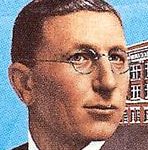Sir Frederick Banting is undisputedly one of this country’s most notable and admired citizens. A veteran of the First World War, chief discoverer of insulin and co-winner along with J.J.R. Macleod of the Nobel Prize for Medicine in 1923, Banting made an indelible contribution to the lives of Canadians and those around the world who suffer from diabetes.
If you work at the Royal Canadian Mint, however, Banting is a name that must not be spoken.
The Mint this year intends to release a $2 coin commemorating the 100th anniversary of the discovery of insulin in 1921. The imagery will feature vials, an Erlenmyer flask, a mortar and pestle, insulin molecules, blood cells and even a couple of maple leaves. But there will be no image of Dr. Banting, a man named the fourth Greatest Canadian in a 2004 CBC television series of the same name.
Imagine issuing a commemorative coin for Terry Fox and including only his running shoes, or printing paper currency of Oscar Peterson featuring just his piano.
While it is true that Banting was not the sole researcher behind this tremendous advancement in medicine, he has become the person most associated with the discovery. But neither Banting nor his other associates – Charles Best and James Collip – are even mentioned in the Mint’s official Canada Gazette notice explaining the objective of the coin. Were there any hearts and minds behind this monumental achievement? The Mint does not say.
Numerous MPs have invoked Banting’s name this year in their comments about the 100th anniversary. So why no image of a man whom Parliament gave an annuity “sufficient to permit Dr. Banting to devote his life to medical research”? Is it possible that Banting et al do not fit the zeitgeist of the times? After all, a 2019 cabinet directive for commemoration asks that the legacies of “colonialism, patriarchy and racism” be considered in any observances.
Perhaps. Interestingly though, the Mint is also issuing a $1 coin commemorating the 125th anniversary of the Klondike Gold Rush of 1896. These coins, however, will feature four figures: Keish (“Skookum Jim”), Káa Goox (“Dawson Charlie”), Shaaw Tláa (Kate Carmack) and George Carmak, her husband. The objective of the coin, the Canada Gazette notes, is to draw attention to “the disruption of traditional ways of living and dislocation of communities from traditional gathering places” caused by this defining moment in the history of Canada’s North.
That’s fine. There is a lot to commemorate in Canada’s past and new voices are rightly gaining more attention. Adding faces to our national stories is important, too, because the past is rich with personality.
This applies to all aspects of Canadian history. Turning the discovery of insulin, one of Canada’s greatest scientific achievements, into a faceless laboratory moment is a historic bureaucratic failure. The late historian Michael Bliss, Banting’s biographer, noted the Nobel laureate’s discovery had made him “immortal.” Apparently not.
(Editor’s note: J.D.M. Stewart has been teaching Canadian history for 27 years and is the author of Being Prime Minister)






